This is a list of monitors of the Royal Navy of the United Kingdom.
This is a list of monitors of the Royal Navy of the United Kingdom.
| Main guns | The number and type of the main battery guns |
| Displacement | Ship displacement at standard combat load |
| Propulsion | Number of shafts, type of propulsion system |
| Laid down | The date the keel began to be assembled |
| Commissioned | The date the ship was commissioned |
| Fate | The fate of the ship |

The Humber-class monitors were three river monitors under construction for the Brazilian Navy in Britain in 1913, all three were taken over by the Royal Navy shortly before the outbreak of the First World War and were commissioned as small monitors, seeing extensive service during the war.
| Ship | Main guns | Displacement | Propulsion | Service | ||
|---|---|---|---|---|---|---|
| Laid down | Acquired | Fate | ||||
| HMS Humber (ex-Javary) | 2 × 6 in (15 cm) | 1,260 long tons (1,280 t ) | 2 × shafts triple expansion engines 2 × boilers | 24 Aug 1912 | 8 Aug 1914 | Sold to F. Rijsdijk 17 Sep 1920 for use as a crane lighter |
| HMS Mersey (ex-Madeira) | 2 × 6 in (15 cm) | 1,260 long tons (1,280 t ) | 2 × shafts triple expansion engines 2 × boilers | 24 Aug 1912 | 3 Aug 1914 | Sold for scrap 1921 |
| HMS Severn (ex-Solimoes) | 2 × 6 in (15 cm) | 1,260 long tons (1,280 t ) | 2 × shafts triple expansion engines 2 × boilers | 24 Aug 1912 | 8 Aug 1914 | Sold for scrap 9 May 1921 |
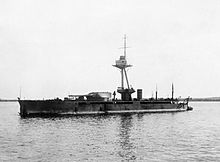
The Abercrombie-class monitors came about when Bethlehem Steel in the United States, the contracted supplier of the main armament for the Greek battleship Salamis being built in Germany, instead offered to sell the four 14"/45 caliber gun twin gun turrets to the Royal Navy on 3 November 1914, the ships were laid down and launched within six months, seeing service throughout the war.
| Ship | Main guns | Displacement | Propulsion | Service | ||
|---|---|---|---|---|---|---|
| Laid down | Commissioned | Fate | ||||
| HMS Abercrombie | 2 × 14 in (36 cm) | 6,150 long tons (6,250 t ) | 2 × vertical triple expansion reciprocating engines 2 × boilers | 12 Dec 1914 | 1 May 1915 | Sold for scrap 25 Jun 1927 |
| HMS Havelock | 2 × 14 in (36 cm) | 6,150 long tons (6,250 t ) | 2 × vertical triple expansion reciprocating engines 2 × boilers | 12 Dec 1914 | May 1915 | Sold for scrap 25 Jun 1921 |
| HMS Raglan | 2 × 14 in (36 cm) | 6,150 long tons (6,250 t ) | 2 × vertical triple expansion reciprocating engines 2 × boilers | 1 Dec 1914 | May 1915 | Sunk 20 Jan 1918 |
| HMS Roberts | 2 × 14 in (36 cm) | 6,150 long tons (6,250 t ) | 2 × vertical triple expansion reciprocating engines 2 × boilers | 17 Dec 1914 | 21 May 1915 | Sold for scrap Sep 1936 |

The Lord Clive-class monitors, sometimes referred to as the General Wolfe-class, were built to meet the need for more shore bombardment ships, using twin 12-inch (305 mm) gun turrets taken from decommissioned Majestic-class pre-dreadnought battleships. Three of the ships, HMS General Wolfe, Lord Clive and Prince Eugene, were converted to take the BL 18 inch Mk I naval gun that had originally been allocated to HMS Furious.
| Ship | Main guns | Displacement | Propulsion | Service | ||
|---|---|---|---|---|---|---|
| Laid down | Acquired | Fate | ||||
| HMS Lord Clive | 2 × 12 in (30 cm) later also 1 × 18 in (46 cm) | 6,150 long tons (6,250 t ) | 2 × shafts reciprocating steam engines 2 × boilers | 9 January 1915 | 10 July 1915 | Sold for scrap 10 October 1927 |
| HMS General Craufurd | 2 × 12 in (30 cm) | 6,150 long tons (6,250 t ) | 2 × shafts reciprocating steam engines 2 × boilers | 9 January 1915 | 26 August 1915 | Sold for scrap 1921 |
| HMS Earl of Peterborough | 2 × 12 in (30 cm) | 6,150 long tons (6,250 t ) | 2 × shafts reciprocating steam engines 2 × boilers | 16 January 1915 | 23 September 1915 | Sold for scrap 1921 |
| HMS Sir Thomas Picton | 2 × 12 in (30 cm) | 6,150 long tons (6,250 t ) | 2 × shafts reciprocating steam engines 2 × boilers | 16 January 1915 | 30 September 1915 | Sold for scrap 1921 |
| HMS Prince Eugene | 2 × 12 in (30 cm) conversion to 1 × 18 in (46 cm) incomplete at armistice | 6,150 long tons (6,250 t ) | 2 × shafts reciprocating steam engines 2 × boilers | 1 February 1915 | September 1915 | Sold for scrap 1921 |
| HMS Prince Rupert | 2 × 12 in (30 cm) | 6,150 long tons (6,250 t ) | 2 × shafts reciprocating steam engines 2 × boilers | 12 January 1915 | May 1915 | Sold for scrap 1923 |
| HMS Sir John Moore | 2 × 12 in (30 cm) | 6,150 long tons (6,250 t ) | 2 × shafts reciprocating steam engines 2 × boilers | 13 January 1915 | May 1915 | Sold for scrap 1921 |
| HMS General Wolfe | 2 × 12 in (30 cm) later also 1 × 18 in (46 cm) | 6,150 long tons (6,250 t ) | 2 × shafts reciprocating steam engines 2 × boilers | January 1915 | 27 October 1915 | Sold for scrap 1923 |

The Marshal Ney-class monitors were built to use the two modern 15-inch turrets made available by the redesign of Renown and Repulse as battlecruisers.
| Ship | Main guns | Displacement | Propulsion | Service | ||
|---|---|---|---|---|---|---|
| Laid down | Commissioned | Fate | ||||
| HMS Marshal Soult | 2 × 15 in (38 cm) | 6,670 long tons (6,780 t ) | 2 × shafts Diesel engines | August 1918 | Sold for scrap 10 July 1946 | |
| HMS Marshal Ney | 2 × 15 in (38 cm) | 6,670 long tons (6,780 t ) | 2 × shafts Diesel engines | August 1915 | Sold for scrap 1957 | |

The Gorgon-class monitors were originally built as coastal defence ships for the Royal Norwegian Navy, but requisitioned for British use.
| Ship | Main guns | Displacement | Propulsion | Service | ||
|---|---|---|---|---|---|---|
| Laid down | Commissioned | Fate | ||||
| HMS Gorgon (ex-Nidaros) | 2 × 9.2 in (23 cm) | 5,746 long tons (5,838 t ) | 2 × shafts Vertical triple-expansion steam engines 4 × boilers | 11 June 1913 | 1 May 1918 | Sold for scrap 26 August 1928 |
| HMS Glatton (ex-Bjørgvin) | 2 × 9.2 in (23 cm) | 5,746 long tons (5,838 t ) | 2 × shafts Vertical triple-expansion steam engines 4 × boilers | 26 May 1913 | 31 August 1918 | Wrecked by explosion 16 September 1918, 79 killed |

The M15-class monitors were fourteen ships ordered in March 1915, as part of the War Emergency Programme of ship construction, mounting 9.2 inch Mk VI gun turrets removed from the Edgar-class and the Mk X turrets held in stock for the Drake-class and Cressy-class cruisers.
| Ship | Main guns | Displacement | Propulsion | Service | ||
|---|---|---|---|---|---|---|
| Laid down | Commissioned | Fate | ||||
| HMS M15 | 1 × 9.2 in (23 cm) | 540 long tons (550 t ) | 4 × shafts 4-cylinder semi-diesel engines | 1 March 1915 | June 1915 | Sunk by UC-38 on 11 November 1917, 26 killed. |
| HMS M16 | 1 × 9.2 in (23 cm) | 540 long tons (550 t ) | 4 × shafts 4-cylinder semi-diesel engines | 1 March 1915 | June 1915 | Sold 29 January 1920 |
| HMS M17 | 1 × 9.2 in (23 cm) | 540 long tons (550 t ) | 4 × shafts 4-cylinder semi-diesel engines | 1 March 1915 | June 1915 | Sold 12 May 1920 |
| HMS M18 | 1 × 9.2 in (23 cm) | 540 long tons (550 t ) | 4 × shafts 4-cylinder semi-diesel engines | 1 March 1915 | July 1915 | Sold 29 January 1920 |
| HMS M19 | 1 × 9.2 in (23 cm) | 540 long tons (550 t ) | 4 × shafts 4-cylinder semi-diesel engines | 1 March 1915 | June 1915 | Sold 12 May 1920 |
| HMS M20 | 1 × 9.2 in (23 cm) | 540 long tons (550 t ) | 4 × shafts 4-cylinder semi-diesel engines | 1 March 1915 | July 1915 | Sold 29 January 1920 |
| HMS M21 | 1 × 9.2 in (23 cm) later 1 × 7.5 in (19 cm) | 540 long tons (550 t ) | 2 × shafts Triple Expansion steam engines | 1 March 1915 | July 1915 | Sunk 20 October 1918 off Dover |
| HMS M22 (later HMS Medea) | 1 × 9.2 in (23 cm) | 540 long tons (550 t ) | 2 × shafts Triple Expansion steam engines | 1 March 1915 | August 1915 | Converted to a minelayer in 1920, renamed HMS Medea 1925, became a training ship 1937, sold 1938, wrecked 2 January 1939 |
| HMS M23 (later RNVR Claverhouse) | 1 × 9.2 in (23 cm) later 1 × 7.5 in (19 cm) | 540 long tons (550 t ) | 4 × shafts 4-cylinder semi-diesel engines | 1 March 1915 | July 1915 | Became a Royal Naval Volunteer Reserve drillship, and was renamed Claverhouse in 1922, sold 1959 |
| HMS M24 | 1 × 9.2 in (23 cm) later 1 × 7.5 in (19 cm) | 540 long tons (550 t ) | 4 × shafts Campbell 4-cylinder paraffin engines | 1 March 1915 | August 1915 | Sold 29 January 1920 for conversion to a mercantile oil tanker, and renamed Satoe |
| HMS M25 | 1 × 9.2 in (23 cm) later 1 × 7.5 in (19 cm) | 540 long tons (550 t ) | 4 × shafts 4-cylinder semi-diesel engines | 1 March 1915 | September 1915 | Scuttled in the Dvina River 16 September 1919 |
| HMS M26 | 1 × 9.2 in (23 cm) later 1 × 7.5 in (19 cm) | 540 long tons (550 t ) | 4 × shafts 4-cylinder semi-diesel engines | 1 March 1915 | October 1915 | Sold 29 January 1920 |
| HMS M27 | 1 × 9.2 in (23 cm) later 1 × 6 in (15 cm) | 540 long tons (550 t ) | 4 × shafts 4-cylinder semi-diesel engines | 1 March 1915 | November 1915 | Scuttled in the Dvina River 16 September 1919 |
| HMS M28 | 1 × 9.2 in (23 cm) later 1 × 6 in (15 cm) | 540 long tons (550 t ) | 4 × shafts 4-cylinder semi-diesel engines | 1 March 1915 | August 1915 | Sunk during the Battle of Imbros on 20 January 1918, 11 killed |

The M29-class monitors were five ships ordered in March 1915, as part of the War Emergency Programme of ship construction.
| Ship | Main guns | Displacement | Propulsion | Service | ||
|---|---|---|---|---|---|---|
| Laid down | Commissioned | Fate | ||||
| HMS M29 (later HMS Medusa, HMS Talbot & HMS Medway II) | 2 × 6 in (15 cm) | 535 long tons (544 t ) | 4 × shafts Triple expansion engines. Oil fuel 45 tons boilers | 1 March 1915 | June 1915 | Converted to minelayer and renames HMS Medusa in 1925, converted to a repair ship and became the depot ship and renames HMS Talbot in 1941, again renamed HMS Medway II in 1944, sold in December 1946 for breaking |
| HMS M30 | 2 × 6 in (15 cm) | 535 long tons (544 t ) | 4 × shafts Triple expansion engines. Oil fuel 45 tons boilers | 1 March 1915 | July 1915 | Sunk by shore batteries at the Gulf of Smyrna 14 May 1916 |
| HMS M31 (later HMS Melpomene, then HMS Menelaus) | 2 × 6 in (15 cm) | 535 long tons (544 t ) | 4 × shafts Triple expansion engines. Oil fuel 45 tons boilers | 1 March 1915 | July 1915 | Converted to minelayer in 1923, renamed HMS Melpomene in 1925, converted to a torpedo training vessel in 1939, renamed HMS Menelaus in 1941, in 1944, sold in 1948 for breaking |
| HMS M32 | 2 × 6 in (15 cm) | 535 long tons (544 t ) | 4 × shafts Triple expansion engines. Oil fuel 45 tons boilers | 1 March 1915 | June 1915 | Sold on January 1920 for use as an oil tanker, and named Ampat |
| HMS M33 (later HMS Minerva and Hulk C23) | 2 × 6 in (15 cm) | 535 long tons (544 t ) | 4 × shafts Triple expansion engines. Oil fuel 45 tons boilers | 1 March 1915 | June 1915 | Converted to mine-laying training ship and was renamed HMS Minerva in 1925, later became a fuelling hulk and boom defence workshop, renamed Hulk C23, currently museum ship at Portsmouth |

The Erebus-class monitors were two ships mounting a single twin BL 15 inch Mk I naval gun turret. They saw active service in World War I off the Belgian coast, were placed in reserve between the wars then served in World War II, with Terror being lost in 1941 and Erebus surviving to be scrapped in 1946.
| Ship | Main guns | Displacement | Propulsion | Service | ||
|---|---|---|---|---|---|---|
| Laid down | Commissioned | Fate | ||||
| HMS Erebus | 2 × 15 in (38 cm) | 8,000 long tons (8,100 t ) | 2 × shafts 4 x oil-fired boilers | 12 October 1915 | 2 September 1916 | Scrapped July 1946 |
| HMS Terror | 2 × 15 in (38 cm) | 8,000 long tons (8,100 t ) | 2 × shafts 4 x oil-fired boilers | 26 October 1915 | 6 August 1916 | Sunk 23 February 1941 off Derna, Libya |

The Roberts-class monitors were two ships mounting a single twin BL 15 inch Mk I naval gun turret built during the Second World War, featuring shallow draught for operating inshore, broad beam to give stability and a high observation platform to observe fall of shot.
| Ship | Main guns | Displacement | Propulsion | Service | ||
|---|---|---|---|---|---|---|
| Laid down | Commissioned | Fate | ||||
| HMS Roberts | 2 × 15 in (38 cm) | 7,970 long tons (8,100 t ) | 2 × shafts 2 × Parsons steam turbines 2 × boilers | 30 April 1940 | 27 October 1941 | Sold for scrap June 1965 |
| HMS Abercrombie | 2 × 15 in (38 cm) | 8,536 long tons (8,673 t ) | 2 × shafts 2 × Parsons steam turbines 2 × boilers | 26 April 1941 | 5 May 1943 | Scrapped 24 December 1954 |

A monitor is a relatively small warship that is neither fast nor strongly armored but carries disproportionately large guns. They were used by some navies from the 1860s, during the First World War and with limited use in the Second World War.

HMS Erebus was a First World War monitor launched on 19 June 1916 and which served in both world wars. She and her sister ship Terror are known as the Erebus class. They were named after the two bomb vessels sent to investigate the Northwest Passage as part of Franklin's lost expedition (1845–1848), in which all 129 members eventually perished.
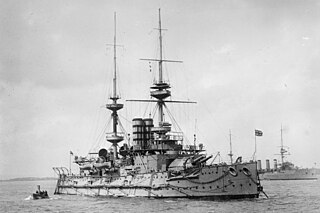
The Majestic class of nine pre-dreadnought battleships were built for the Royal Navy in the mid-1890s under the Spencer Programme, named after the First Lord of the Admiralty, John Poyntz Spencer. With nine units commissioned, they were the most numerous class of battleships. The nine ships, HMS Majestic, Caesar, Hannibal, Illustrious, Jupiter, Magnificent, Mars, Prince George, and Victorious, were built between 1894 and 1898 as part of a programme to strengthen the Royal Navy versus its two traditional rivals, France and Russia. This continued the naval re-armament initiatives begun by the Naval Defence Act 1889.
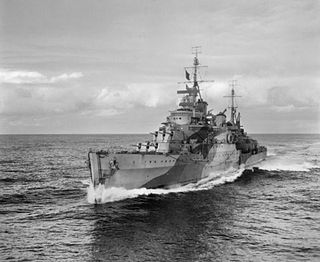
The Town class consisted of 10 light cruisers built for the Royal Navy during the 1930s. The Towns were designed to the constraints imposed by the London Naval Treaty of 1930. The ships were built in three distinct sub-classes, the Southampton, Gloucester and Edinburgh classes respectively, each sub-class adding on further weaponry.

The Dido class consisted of sixteen light cruisers built for the Royal Navy during World War II. The first group of three ships were commissioned in 1940; the second group of six ships and third group of two were commissioned between 1941 and 1942. A fourth group, also described as the Improved Dido or Bellona class were commissioned between 1943 and 1944. Most members of the class were given names drawn from classical history and legend. The groups differed in armament, and for the Bellonas, in function. The Dido class were designed as small trade protection cruisers with a secondary role in the battlefleet as large flotilla leaders. As designed, they mounted five twin 5.25-inch high-angle gun turrets on the centreline providing dual-purpose anti-air and anti-surface capacity; the complex new turrets were unreliable when introduced, and somewhat unsatisfactory at a time when the UK faced a fight for survival. During the war, the original 1939-42 ships required extensive refit work to increase electrical generating capacity for additional wartime systems and in the final Bellona,HMS Diadem, fully-electric turrets. While some damage was experienced initially in extreme North Atlantic weather, changes to gun handling and drill partially mitigated the problems. The fitting of the three forward turrets in the double-superfiring A-B-C arrangement relied upon the heavy use of aluminium in the ships' superstructure, and the lack of aluminium after the evacuation of the British Army from France was one of the primary reasons for the first group only receiving four turrets, while the third group received four twin 4.5-inch mounts and no 5.25-inch guns at all. The Bellonas were designed from the start with four radar-directed 5.25-inch gun turrets with full Remote Power Control and an expanded light anti-aircraft battery, substantially increasing their efficiency as AA platforms.

The Courageous class consisted of three battlecruisers known as "large light cruisers" built for the Royal Navy during the First World War. The class was nominally designed to support the Baltic Project, a plan by Admiral of the Fleet Lord Fisher that was intended to land troops on the German Baltic Coast. Ships of this class were fast but very lightly armoured, with only a few heavy guns. They were given a shallow draught, in part to allow them to operate in the shallow waters of the Baltic but also reflecting experience gained earlier in the war. To maximize their speed, the Courageous-class battlecruisers were the first capital ships of the Royal Navy to use geared steam turbines and small-tube boilers.

The QF 4.5 inch gun has been the standard medium-calibre naval gun used by the Royal Navy as a medium-range weapon capable of use against surface, aircraft and shore targets since 1938. This article covers the early 45-calibre family of guns up to the 1970s. For the later unrelated 55-calibre Royal Navy gun, see 4.5 inch Mark 8 naval gun. Like all British nominally 4.5 inch naval guns, the QF Mk I has an actual calibre of 4.45 inches (113 mm).

The BL 15-inch Mark I succeeded the BL 13.5-inch Mk V naval gun. It was the first British 15-inch (380 mm) gun design and the most widely used and longest lasting of any British designs, and arguably the most successful heavy gun ever developed by the Royal Navy. It was deployed on capital ships from 1915 until 1959 and was a key Royal Navy gun in both World Wars.

The Lord Clive-class monitor, sometimes referred to as the General Wolfe class, were ships designed for shore bombardment and were constructed for the Royal Navy during the First World War.

The BL 18-inch Mk I naval gun was a breech-loading naval rifle used by the Royal Navy during World War I. It was the largest and heaviest gun ever used by the British. Only the Second-World-War Japanese 46 cm/45 Type 94 had a larger calibre, 18.1 inches (46 cm), and it fired a lighter shell. The gun was a scaled-up version of the BL 15 inch Mk I naval gun and was developed to equip the "large light cruiser" Furious. Its barrel length of 60 ft (18 m) was just 40 calibres, slightly limiting its muzzle velocity.
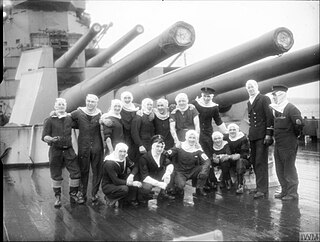
The BL 14-inch Mk VII naval gun was a breech loading (BL) gun designed for the battleships of the Royal Navy in the late 1930s. This gun armed the King George V-class battleships during the Second World War.
HMS Prince Eugene was one of eight Lord Clive-class monitors built for the Royal Navy in 1915 to conduct shore bombardments during the First World War. The ship was assigned to the Dover Patrol for the duration of the war and provided cover for the Inshore Squadron during the First Ostend Raid. She was sold for scrap in 1921.

HMS General Wolfe, also known as Wolfe, was a Lord Clive-class monitor which was built in 1915 for shore-bombardment duties in the First World War. Her class of eight ships was armed by four obsolete Majestic-class pre-dreadnoughts which had their 12-inch guns and mounts removed, modified and installed in the newly built monitors. Wolfe spent her entire war service with the Dover Patrol, bombarding the German-occupied Belgian coastline, which had been heavily fortified. In the spring of 1918 she was fitted with an 18-inch (457 mm) gun, with which she made the longest-range firing in the history of the Royal Navy - 36,000-yard (20 mi) - on a target at Snaeskerke, Belgium. After the war, she was laid up before being stripped and put up for sale in 1920. She was finally scrapped in 1923.
HMS Sir John Moore was one of eight Lord Clive-class monitors built for the Royal Navy in 1915 to conduct shore bombardments during the First World War. The ship was assigned to the Dover Patrol for the duration of the war and was sold for scrap in 1921.

The QF 6-inch 40 calibre naval gun (Quick-Firing) was used by many United Kingdom-built warships around the end of the 19th century and the start of the 20th century.
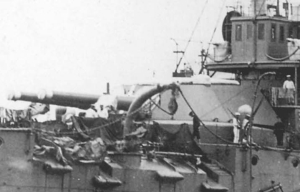
The Armstrong Whitworth 12-inch naval gun of 40 calibres length was designed by and manufactured mainly by Armstrong's ordnance branch, Elswick Ordnance Company. It was intended for the Royal Navy's Royal Sovereign-class battleships, but budgetary constraints delayed their introduction. The first units were instead supplied to Japan. As the Type 41 12-inch (305 mm) 40-calibre naval gun it was the standard main battery on several early United Kingdom-built pre-dreadnought battleships of the Imperial Japanese Navy.

The QF 4 inch Mk XVI gun was the standard British Commonwealth naval anti-aircraft and dual-purpose gun of World War II.

The BL 12-inch Mark VIII naval gun was one of the first large British rifled breech-loading naval guns designed for the higher pressures generated by the new cordite propellant of the 1890s, and Britain's first large wire-wound gun. It represented a major advance compared to previous British guns.

The 14-inch/45 caliber gun,, whose variations were known initially as the Mark 1, 2, 3, and 5, and, when upgraded in the 1930s, were redesignated as the Mark 8, 9, 10, and 12. They were the first 14-inch (356 mm) guns to be employed by the United States Navy. The 14-inch/45 caliber guns were installed as the primary armament aboard all of the United States Navy's New York-class, Nevada-class, and Pennsylvania-class battleships. The gun also saw service in the British Royal Navy, where it was designated BL 14 inch gun Mk II.

By taking on ships being built for foreign navies in British shipyards, a number of British-built 6-inch 50-calibre naval guns found their way into British service in World War I. Their specifications and performance differed from standard Royal Navy 6-inch guns but in British service they fired standard service 100-pound projectiles.